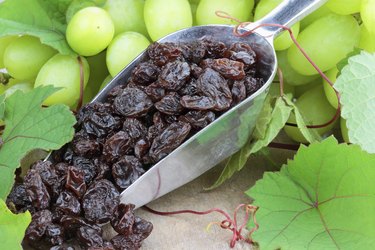
Introduced in California in the late 1800s, "Thompson Seedless" (Vitis vinifera "Thompson Seedless") bears light green, seedless grapes used for making fresh, raisins and grape juice. It's also known as "Sultana." Hardy in U.S. Department of Agriculture plant hardiness zones 7 through 9, deciduous vines grow 20 to 25 feet each year and need annual training to produce well. The grapes ripen in summer's heat, usually turning yellowish or whitish when they're ready to pick.
Soil and Light
Video of the Day
A wide variety of soil types are suitable for Thompson Seedless, as long as there's good drainage. If soil is sandy or has a high percentage of clay, amend the soil with organic matter before planting. Add a 2-inch layer of aged compost to the soil and dig it in. The vines need full sun.
Video of the Day
Planting Vines
Young vines become available as dormant, bare-root plants in winter, and should be chosen and planted as soon as they are available to prevent roots from drying out. The planting hole should be a little bigger and deeper than the roots. Spread the roots out in the hole, cover them with the removed soil, and tamp the soil down firmly. Space plants 8 feet apart. Put a 6-foot stake next to the vine.
Watering Needs
Bring soil from elsewhere to build a raised, round basin around the planted grapevine. Flood the basin to water the plant. You can also install drip irrigation. To conserve soil moisture, put a 2- to 4-inch-deep layer of mulch such as bark or straw in the basin. Water the young vine regularly for the first year, letting the top 1 to 2 inches of soil dry between waterings. In established vines, when grapes are developing, water regularly so grapes will grow large and stay juicy.
Fertilizer Use
Too much nitrogen can cause excessive leaf and stem growth at the expense of fruits. Use a complete fertilizer such as 10-10-10. Apply about 1/4 pound in the grapevine's second year when the new buds begin to swell in late winter or early spring. Scatter it lightly around the plant in a circle 4 feet wide. Rake it in and water thoroughly. For older plants, if the previous season's growth was slow, add about 1 pound of fertilizer in an 8-foot-wide circle.
Training Vines
Probably the best thing you can do for your Thompson Seedless is to cut it back each year except for the first season, when you can let it grow against the stake. During the second year, install a trellis with horizontal supports and begin to shape the growth. Grapevines are pruned by two methods, the spur and the cane methods. Thompson Seedless is best suited to cane pruning, since the most productive buds are higher on the canes than in most other grape varieties. For cane pruning, the aim is to produce mature vines that have four to six main canes trained along the horizontal support of a trellis, each cane with about 15 buds.
- UC Integrated Viticulture: Thompson Seedless
- Monrovia: Thompson Seedless Grape
- University of California Extension: Growing Grapes in Your Backyard: How Do I Plant and Care for Young Vines?
- University of California Extension: Growing Grapes in Your Backyard: How Do I Plant Bare-Root Vines/
- University of California Extension: Growing Grapes in Your Backyard: How Do I Water and Mulch the Young Vine?
- National Gardening Association: Care & Harvesting of Grapes
- National Gardening Association: Fertilizing Thompson Seedless Grapes
- University of California Cooperative Extension Tulare County: Water Management for Grapevines
- University of California Extension: Growing Grapes in Your Backyard: How Do I Prune at the End of the First Growing Season?
- University of California Cooperative Extension Tulare County: Thompson Seedless
- Reader's Digest: How to Know When to Harvest Grapes